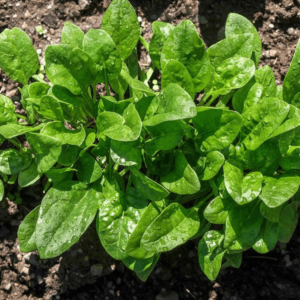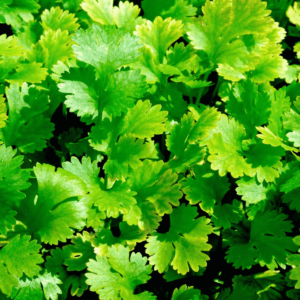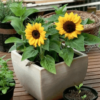Mini Sunflower Seeds
- Brand: Plantozia
₹35.00₹100.00 (-65%)
9 in stock
- Packet contain: 1-Pack Seeds.
- Sowing season: Summer.
- Mode of showing: Show the Mini Sunflower Seeds 0.5 cm deep in a seeding tray / container / pots. Transplant in 30-45 days.
- Germination Time: 7 to 14 days from showing.
- Harvesting: Mini Sunflower Seeds 70-80 days after transplanting.
MINI SUNFLOWER SEEDS GERMINATION PROCESS
1. Soaking for Better Results: Before planting your Mini Sunflower Seeds, soak them in water for 5-6 hours. This helps soften the seed coat, allowing moisture to penetrate more easily and speeding up the germination process. Soaking can also improve the chances of successful sprouting by giving the Mini Sunflower Seeds a head start. Once soaked, drain the water and proceed to the next step.
2. Choosing the Right Soil: For optimal growth, select a well-draining soil that is rich in organic matter. A good potting mix or garden soil with added compost works well. Mini Sunflower Seeds thrive in slightly acidic to neutral pH levels (between 6.0 and 7.5). Ensure the soil is loose and not compacted, as this will allow the roots to spread easily, providing a strong foundation for the growing plant.
3. Planting the Seeds: Plant the soaked mini sunflower seeds about 1 inch deep into the soil, spacing them approximately 6 inches apart. If you’re planting in containers, ensure the pots have drainage holes to prevent waterlogging. Cover the seeds lightly with soil and gently press down to secure them. Water the soil lightly after planting to settle the seeds in their new environment.
4. Watering Guidelines: While it’s important to keep the soil moist, be careful not to overwater. Overwatering can lead to root rot or fungal diseases, which can harm or even kill the young seedlings. Water the soil when the top 1-2 inches feel dry to the touch. In the early stages, keeping the soil consistently moist is crucial for germination, but as the plants grow, they become more drought-tolerant.
5. Providing Adequate Light: Mini Sunflower Seeds love sunlight. Place the pots or seedbed in a location where they can receive at least 6-8 hours of direct sunlight daily. If growing indoors, a sunny windowsill or a grow light can be used to ensure the seedlings get enough light. Lack of sunlight may cause the plants to become leggy and weak.
6. Enjoy Your Flowers: After about 2-3 months of care, your Mini Sunflower Seeds will begin to bloom. At this stage, continue to provide regular watering, but avoid getting water on the flowers to prevent mildew. The bright, cheerful blooms are not only beautiful but can also attract pollinators like bees to your garden. Once the flowers have fully matured, you can enjoy their vibrant display or harvest the Mini Sunflower Seeds for future planting or as a healthy snack.
MINI SUNFLOWER SEEDS SPECIFICATION
| Common Name | Sunflower, Mini Sunflower, Sunflower Miniature Flower, Surjamukhi. |
| Height | 2–4 ft tall. |
| Harvesting Time | 70–80 days after sowing. |
| Bloom Time | Summer. |
| Difficulty Level | Easy to grow. |
GROWING MINI SUNFLOWER PLANTS IN POTS :
1. Choosing the Right Pot
- Size: Mini sunflowers require a pot that’s at least 6-8 inches in diameter and 8-10 inches deep. A larger pot helps accommodate the plant’s root system and ensures it has enough space to grow.
- Material: Choose a pot made of terracotta, plastic, or ceramic with drainage holes at the bottom. Drainage is crucial to prevent water from pooling, which can lead to root rot.
2. Selecting the Soil
- Type: Use well-draining potting soil with a mix of sand, perlite, or vermiculite to ensure good aeration and drainage.
- pH Level: Sunflowers prefer slightly acidic to neutral soil with a pH of 6.0-7.0. You can use a soil test kit to check the pH and adjust it if necessary.
3. Planting the Seeds
- Seed Depth: Plant the Mini Sunflower Seeds about 1 inch deep into the soil. Place 2-3 seeds per pot to ensure at least one strong plant emerges.
- Spacing: If multiple seeds germinate, thin them out, leaving the strongest seedling to grow.
- Watering After Planting: Water the soil thoroughly after planting to help the seeds settle and start the germination process.
4. Providing Adequate Light
- Sunlight Requirements: Mini sunflowers need full sun, which means at least 6-8 hours of direct sunlight each day. Place the pot in a sunny spot like a balcony, patio, or windowsill.
- Indoor Growing: If growing indoors, place the pot near a south-facing window or use a grow light to ensure the plant receives sufficient light.
5. Watering the Plant
- Frequency: Water regularly to keep the soil consistently moist, but not soggy. The top inch of soil should dry out between waterings.
- Method: Water slowly and deeply to encourage deep root growth. Avoid getting the leaves wet to reduce the risk of fungal diseases.
- Seasonal Adjustment: Reduce watering frequency in cooler months as the plant’s growth slows down.
6. Fertilizing
- Type: Use a balanced, slow-release fertilizer or a liquid fertilizer diluted to half strength. A 10-10-10 or 20-20-20 formula is suitable.
- Frequency: Fertilize every 2-4 weeks during the growing season (spring and summer) to promote healthy growth and flowering.
- Avoid Over-fertilizing: Too much fertilizer can lead to excessive foliage at the expense of flowers. Follow the instructions on the fertilizer package to avoid overfeeding.
7. Supporting the Plant
- Staking: As mini sunflowers grow, they may need support to keep the stems upright. Insert a small stake into the pot and loosely tie the stem to the stake with soft ties.
- Wind Protection: If placed outdoors, protect the plant from strong winds that could damage the stems or knock over the pot.
8. Managing Pests and Diseases
- Common Pests: Watch out for aphids, spider mites, and snails, which can damage the plant. Use insecticidal soap or neem oil to control these pests.
- Diseases: Fungal diseases like powdery mildew and root rot can occur if the plant is overwatered or lacks air circulation. Ensure proper spacing, adequate sunlight, and well-draining soil to prevent these issues.
- Regular Monitoring: Regularly inspect your plant for signs of pests or disease, and take action promptly if you notice any issues.
9. Pruning and Deadheading
- Deadheading: Remove spent flowers to encourage the plant to produce more blooms. This also helps maintain the plant’s appearance and directs energy toward new growth.
- Pruning: If the plant becomes leggy or overgrown, trim back excess growth to encourage a bushier shape.
10. Harvesting Seeds
- Timing: If you wish to harvest seeds, allow some flowers to remain on the plant after blooming. The seeds will develop and mature as the flower heads dry out.
- Collecting Seeds: Once the flower head has dried completely, gently rub it to release the seeds. Store the seeds in a cool, dry place for future planting.
11. Overwintering and Replanting
- Annual Growth: Mini sunflowers are typically grown as annuals, meaning they complete their life cycle in one growing season. After flowering, the plant will begin to die back.
- Overwintering: In warmer climates, you can try to overwinter the plant indoors by cutting it back and reducing watering. However, many gardeners prefer to start fresh with new seeds each season.
- Replanting: If you wish to grow mini sunflowers again, clean the pot thoroughly, refresh the soil, and plant new seeds in the spring.
12. Enjoying Your Mini Sunflowers
- Aesthetic Appeal: Mini sunflowers are not only easy to grow but also add a cheerful, bright touch to any space. Whether indoors or out, they’re sure to bring joy with their sunny blooms.
- Continuous Blooming: With proper care, mini sunflowers can bloom throughout the growing season, providing a continuous display of vibrant yellow flowers.
By following these guidelines, you can successfully grow Mini Sunflower Seeds in pots, adding a burst of sunshine to your home or garden.
Additional information
| Weight | 0.1 kg |
|---|---|
| Dimensions | 5 × 5 × 5 cm |
Only logged in customers who have purchased this product may leave a review.













Reviews
There are no reviews yet.